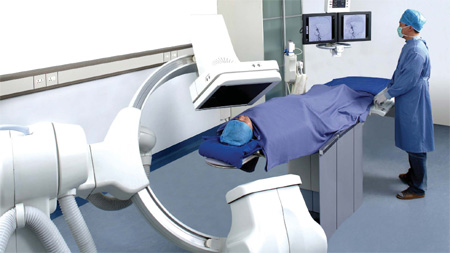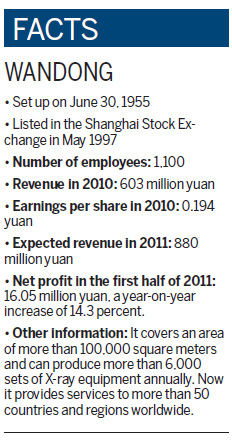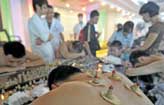Technology
Cutting-Edge Catch-UP
Updated: 2011-07-29 13:54
By Zhao Yanrong (China Daily European Weekly)
|
 Wandong ranks sixth in the world for enterprises specializing in radiation equipment. Provided to China Daily
|
Chinese medical equipment companies are now more than a match for their western counterparts
Ten years ago, Xie Yufeng, vice-president and chief engineer at Beijing Wandong Medical Equipment Co, slept little and ate poorly trying to lead a team of six engineers in figuring out why their X-ray machine was incapable of withstanding the same amount of voltage and current as Western X-ray machines.
"We went through every part of our equipment, many times, and we thought it should have been totally on par with (equipment used in Western hospitals at the time)," Xie says. "But we just could not do it. It was very disappointing."
Since the middle of the 1990s, the Chinese development of medical equipment has sounded very similar to Xie's story.
Even 15 years back, Chinese companies were still analyzing and copying first-generation equipment that used cathode ray tubes when Western engineers were beginning to use liquid crystal displays in third-generation medical photographic equipment.
But today, Chinese medical equipment companies such as Wandong, Xie says, have caught up with Western medical equipment technology and are starting to compete with Western companies for sales to hospitals in China.
One reason why China is placing more emphasis on innovation in the medical equipment industry are the staggering sales figures in recent years.
The country's medical device sales reached 120 billion yuan (12.9 billion euros) in 2010, up 23 percent from the previous year, according to the China Association for Medical Devices Industry, though industry analysts say foreign companies currently control nearly 70 percent of China's high-end medical device market.
And there lies the niche for Chinese companies - targeting the low end markets - as well as a major opportunity for Wandong.
According to a report titled "The Top 10 Competitiveness Enterprises in China's Medical Devices Industry during 2009-2010" by the Shanghai Institute of Biomedical Engineering, Wandong ranked sixth in the world for enterprises specializing in radiation equipment. No Chinese company had been listed before.
Wandong is the first medical equipment company in China, established in 1955, the largest Chinese medical equipment manufacturer and has more than 1,000 workers. Headquartered in Zhongguancun Science and Technology Park in northwestern Beijing, the company produces 6,000 sets of X-ray equipment and 100 sets of nuclear magnetic resonance equipment a year, making Wandong the second most productive radioautography equipment maker in the world.
It became the first listed Chinese medical equipment company, back in 1997.
Wandong is currently working to make its devices more affordable for most Chinese hospitals, especially walk-in clinics and hospitals in the countryside and in towns.
"Imported devices are way too expensive for most hospitals and clinics in China," Xie says.
He says that some imported medical devices can reach as high as 2 million yuan.
Once Wandong masters how to make the equipment, prices for its products can cost as little as half that, Xie says.
"Foreign equipment sells expensively in China because developers hold exclusive rights and thus it costs much less for our clients when we acquire or develop similar techniques," Xie says.
In 2000, Wandong set up the biggest Chinese imaging technology research and development center in Beijing. The company has invested almost 500 million yuan in the center, which employs 280 engineers.
Wandong cooperates with top hospitals in China, such as Beijing Tongren Hospital, Xuanwu Hospital and Capital Medical University by running the joint clinical research centers.
|
 |
One example of the benefits of the cooperation happened recently, according to Wandong officials. In the neurology department lab at Xuanwu Hospital, doctors were befuddled in trying to superimpose photos of arteries and veins onto one picture.
Patients had to suffer through a number of pictures for doctors to reference but after communicating with the doctors, Wandong's engineers created software that recorded the circulatory system at once.
"It takes only a week for us to solve the problem, which doctors thought was impossible," Xie says. "To combine our production and research to the practical work is the best way to catch up with Western competitors."
Wandong, because it is a Chinese company, says it has also benefited from its understanding of the needs and wants of Chinese people and its hands-on experience with local hospitals and clinics.
In the last five years, Wandong has successfully bid for 98 government procurement programs and provided almost 6,500 units of medical equipment nationwide. About 700 engineers from Wandong are working for thousands of local hospitals and clinics, the company says, and that has reduced the cost of its service and prices for its products compared with prices from foreign competitors.

Specials

Wen pledges 'open' probe
Design flaws in the signal equipment led to Saturday's fatal high-speed train collision, authorities say.

Turning up the heat
Traditional Chinese medicine using moxa, or mugwort herb, is once again becoming fashionable

Ciao, Yao
Yao Ming announced his retirement from basketball, staging an emotional end to a glorious career.